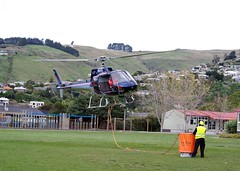
Search
Images for Rocks; more images...
Helicopter flooding off rocks
Images, eqnz.chch.2010
There was a risk of rocks falling off cliffs behind Redcliffs school following Sept 4th earthquake. A helicopter was used to wash off loose rocks to lower the risk to the school.
7.1 earthquake rocks Canterbury
Articles, Manatū Taonga, the Ministry for Culture and Heritage
The earthquake which struck at 4.35 a.m. on a Saturday morning was felt by many people in the South Island and southern North Island. There was considerable damage in central Canterbury, especially in Christchurch, but no loss of life.
Helicopter landing at school
Images, eqnz.chch.2010
There was a risk of rocks falling off cliffs behind Redcliffs school following Sept 4th earthquake. A helicopter was used to wash off loose rocks to lower the risk to the school.
Christchurch Press Image: Don Scott 2010:09:12 15:35:32
Images, UC QuakeStudies
Photograph captioned by Fairfax, "Workmen repairing to remove dangerous rocks/boulders on Castle Hill above the Lyttelton tunnel road".
Fairfax Media Image: Martin Hunter 2010:10:23 18:27:35
Images, UC QuakeStudies
Photograph captioned by Fairfax, "Dave Dobbyn rocks the crowd during the Band Together concert for Canterbury in Hagley Park".
Fairfax Media Image: Martin Hunter 2010:10:23 15:58:50
Images, UC QuakeStudies
Photograph captioned by Fairfax, "Dane Sith rocks to the music during the Band Together concert for Canterbury at Hagley Park".
Fairfax Media Image: Martin Hunter 2010:10:23 15:58:48
Images, UC QuakeStudies
Photograph captioned by Fairfax, "Dane Sith rocks to the music during the Band Together concert for Canterbury at Hagley Park".
From the city that rocks, observations from post-earthquake Christchurch N…
Research papers, Lincoln University
At 4.35 a.m. on the 4th of September 2010 Christchurch residents were shaken awake by a magnitude 7.1 earthquake, the largest earthquake to hit urban New Zealand for nearly 80 years. It was a large earthquake. On average the world only has 17 earthquakes a year larger than magnitude seven. Haiti’s earthquake in January 2010 was magnitude 7.1 and Chile’s earthquake in February was magnitude 8.8. Although it was a big quake, Christchurch was lucky. In Haiti’s earthquake over 230,000 people were killed and in Chile 40,000 homes were destroyed. Happily this was not the situation in Christchurch, however the earthquake has caused considerable damage. The challenge for the Landscape Architecture community is to contribute to the city’s reconstruction in ways that will not only fix the problems of housing, and the city’s urban, suburban and neighbourhood fabric but that will do so in ways that will help solve the landscape problems that dogged the city before the earthquake struck.
Christchurch Press Image: Stacy Squires 2010:09:18 11:28:58
Images, UC QuakeStudies
Photograph captioned by Fairfax, "Garden City Helicopters flown by Mark Read uses a 700 litre monsoon bucket to dump water on loose boulders and rocks on the cliff face above Redcliffs School to dislodge them".
Christchurch Press Image: Stacy Squires 2010:09:18 11:22:01
Images, UC QuakeStudies
Photograph captioned by Fairfax, "Garden City Helicopters flown by Mark Read uses a 700 litre monsoon bucket to dump water on loose boulders and rocks on the cliff face above Redcliffs School to dislodge them".
Christchurch Press Image: Stacy Squires 2010:09:18 11:31:17
Images, UC QuakeStudies
Photograph captioned by Fairfax, "Garden City Helicopters flown by Mark Read uses a 700 litre monsoon bucket to dump water on loose boulders and rocks on the cliff face above Redcliffs School to dislodge them".
Christchurch Press Image: Stacy Squires 2010:09:18 11:36:25
Images, UC QuakeStudies
Photograph captioned by Fairfax, "Garden City Helicopters flown by Mark Read uses a 700 litre monsoon bucket to dump water on loose boulders and rocks on the cliff face above Redcliffs School to dislodge them".
Christchurch Press Image: Stacy Squires 2010:09:18 11:17:44
Images, UC QuakeStudies
Photograph captioned by Fairfax, "Garden City Helicopters flown by Mark Read uses a 700 litre monsoon bucket to dump water on loose boulders and rocks on the cliff face above Redcliffs School to dislodge them. Daniel Currie, ground support crew, steadies the monsoon bucket on takeoff".
Castle Rock scarred
Images, eqnz.chch.2010
The magnitude 7.1 Christchurch earthquake broke off an enormous chunk of Castle Rock in the Port Hills which has tumbled down towards the Lyttelton tunnel. View from Morgan's Valley (-43.578037° 172.714828°).
Scott, Thomas, 1947-:'Whoa! Is this another quake?' 21 September 2010
Images, Alexander Turnbull Library
A house rocks in the night but the occupants are reassured that it is not 'another quake', only an aftershock, which although it causes the walls to crumble is nothing to worry about. Refers to the Canterbury earthquake of 4th September and the dozens of aftershocks that cause continuing tension and anxiety. Quantity: 1 digital cartoon(s).
"We have land for sale and foreigners are welcome!" 19 October 2010
Images, Alexander Turnbull Library
A man and woman clutch each other in terror as their house rocks in an aftershake; the man grabs his phone and offers his land for sale adding that 'foreigners are welcome'. Refers to the Canterbury earthquake of 4th September 2010 which continues to experience aftershakes, some of them quite significant. Refers also to the debate about whether New Zealand should be selling land, particularly farms, to foreigners; one side of the debate considers the sale of land to foreigners to make economic sense while others feel that our heritage is being lost. Both colour and black and white versions of this cartoon are available Quantity: 2 digital cartoon(s).
- 1

